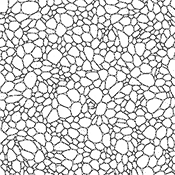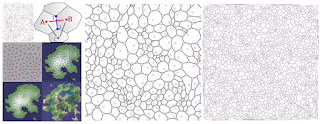The past couple of months I have been looking for a CFD/mesh expert to help convert my simplistic Processing-model into a ...
... Primal-Dual Mesh/Graph-system.
... Primal-Dual Mesh/Graph-system.
The idea is that the 1st mesh constructs the volumetric bubble-lattice (A, B, D, ...); the 2nd mesh is a triangulated-grid that distributes the fluid-currents between the bubbles (ac, bc, cd, ...); and those two are interconnected (acAD), exchanging energy, where the solid volumes can phase-change into gas and visa-versa.
The primal-dual mesh would be like this stress-ball,
one where hot currents make the bubbles expand, and cold currents make them shrink.
Similar to Game of Life where cells live or die, forming pulsating ‘organisms'; but with currents running through the edges between the cells.
On/off, heating and cooling the bubbles.
-----
I. The Primal-Dual-mesh
The 1st mesh is for the volumes: circles/spheres
The 2nd mesh is for the gas in between: edges
Here's a cool reference for a dual-mesh:
Barycenter (centroid) dual-mesh:
Barycenter is important, because the dual-mesh needs to cross correctly, flow runing between the volumes, it also looks more natural and foamy:
In 3D we get a volumetric Tetrahedron-mesh.
-----
II. Three key elements for building this model
A. Spring-damping-mesh
The 1st mesh with the Delaunay-triangulations needs to be a spring-damping-mesh, to calculate and store the tension between the volumes.
Toxiclibs-library can be used that applies Verlet integration:
or Position Based Dynamics (PBD):
B. Fluid-Grid
The 2nd mesh with the Voronoi-diagrams represent the current-network between the volumes and needs to be a kind of fluid-grid to calculate the flow, such as:
• Flow fields (Eulerian):
For example Jos Stam's 'Fluid Method for Games'
• Lattice Gas Automata with scattering rules:
-
• Ore something in the trend of an Electrical-grid ...
C. Spring-damping-mesh with Connect Fluid-Grid
The final key element is connecting the spring-damping-mesh with the fluid-grid, and make them interactive, both parts regulating each-other.
• Volumes (A)(B)(C)(D), with between them paths: (ac)(bc)(cd)
• When flow in (ac) increases, then volume (A) contracts -> (ac) is a variable of (A)
• And visa versa the tension between (AD) regulates the current (ac) -> (AD) is a variable of (ac)
Like Ohm's Law:
Current = Tension / Resistor
-----
III. References
The action should go in the direction of this dual-mesh sim by RedBlobGames:
Amit form RedBlobGames has also a post where he creates islands with rivers on the half-edges of a dual-mesh:
----
A dry-foam simulator by Kenny Erleben:
--
Shimmy, a fun in-browser simulation of a dynamic mesh:
--
Finite Volume Method (FVM) by Darren Engwirda using a Primal-Dual Mesh:
























